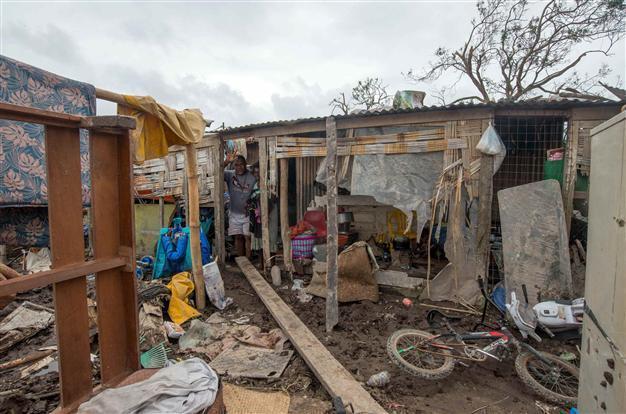Help us rebuild, Vanuatu president urges world
PORT VILA - Agence France-Presse

Local residents stand with their belongings in their damaged home after Cyclone Pam hit Port Vila, the capital city of the Pacific island nation of Vanuatu, March 15, 2015. REUTERS Photo
Vanuatu's president March 16 pleaded with the world to help the cyclone-ravaged Pacific nation rebuild as aid agencies warned conditions were among the most challenging they have ever faced with fears of disease rife.
An emotional President Baldwin Lonsdale said the need was "immediate" after Severe Tropical Cyclone Pam tore through the country on Friday night packing wind gusts of up to 320 kilometres (200 miles) an hour, leaving massive destruction.
"The humanitarian need is immediate, we need it right now," he told AFP as he readied to fly home from a disaster conference in Japan, adding that the poverty-stricken island chain also desperately required longer-term financial support.
"After all the development we have done for the last couple of years and this big cyclone came and just destroyed... all the infrastructure the government has... built. Completely destroyed.
"We need international funding to (re)build all the infrastructure."
Many world leaders have pledged support and military planes from Australia, New Zealand and France were arriving loaded with food, shelter, medicine and generators, along with disaster relief teams.
The official death toll in the battered capital Port Vila, where relief workers said up to 90 percent of homes have been damaged, stands at six with more than 30 injured, although aid workers believe this is likely a fraction of the fatalities caused by the storm.
While the aid missions continued landing in Port Vila, workers on the ground said there was no way to distribute desperately needed supplies across the archipelago's 80 islands, warning it would take days to reach remote villages flattened by the monster storm.
Oxfam country director in Port Vila Colin Collett van Rooyen said a lack of enough clean water, temporary toilets, water purification tablets and hygiene kits needed to be addressed rapidly.
"Friday night was the first emergency with the arrival of Cyclone Pam, disease will be the second emergency without clean water, sanitation and hygiene provision," he said.
"There are more than 100,000 people likely homeless, every school destroyed, full evacuation centres, damage to health facilities and the morgue."
Charlotte Gillan, an Australian paramedic who lives in the village of Tango on the outskirts of Port Vila, said the front part of her house had collapsed.
"I fought tears seeing that devastation," she told the Australian Associated Press news agency, adding that disease was now her main concern.
"With all the rain and rubbish around, there's going to be malaria and dengue, as well as diarrhoea and vomiting with water contamination. People here are reliant on their gardens for food. But all that's gone."
Save the Children's Vanuatu director Tom Skirrow told AFP the logistical challenges were even worse than for Super Typhoon Haiyan, which struck the Philippines in November 2013, leaving more than 7,350 people dead or missing and ravaging an area as big as Portugal.
"I was present for the Haiyan response and I would 100 percent tell you that this is a much more difficult logistical problem," he said.
"The numbers are smaller but the percentage of the population that's been affected is much bigger."
Aurelia Balpe, head of the Pacific office of the International Federation of Red Cross and Red Crescent Societies, agreed that the task facing aid agencies was likely unprecedented in the region.
"I don't think there has ever been destruction on this scale in one place," she told AFP.
Skirrow said flights over remote islands in the archipelago, which spans more than 12,000 square kilometres (4,700 square miles), had confirmed widespread destruction elsewhere in the nation of 270,000.
Balpe said initial reports from two volunteers in the northern Torres and Banks islands were not as devastating, but no contact had been established with other areas and it appeared the southern island of Tanna had suffered widespread damage.
"He was very traumatised," she said of a local Red Cross volunteer who was contacted on Tanna.
"He sounded like he was in shock and we couldn't get very much information from him, just that there was devastation."
Pacific nations regard themselves as at the frontline of climate change, given many are low-lying islands dangerously exposed to rising sea levels, and Lonsdale said changing weather patterns were partly to blame for the destruction.
"Climate change is contributing to the disaster in Vanuatu," he told reporters in Japan.
"This year we have had more (rain) than other years and for the last couple of weeks, the heavy rain has exceeded what has happened in the past."
Asked by AFP how his people were reacting to the disaster, he replied: "They are coping but it will take some time before they can recover and start a normal life again."
Communications were still down across most of the islands, although the airport in Port Vila re-opened to commercial flights on Monday.
